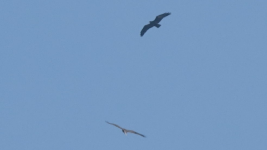One lives and learns. I should be glad to see some published examples that show this effect, and a more detailed analysis - if you know one - of the ins and outs of it. It must render a great many high-quality photos unreliable, and this is not a general caveat of which I'm aware. Insofar as I am aware of it, one needs a hugely-faster-moving subject before any effect shows up, eg the spinning prop blades of an aircraft. In any case, AFAIK, there would be absolutely zero effect in the photos here that you refer to as the birds appear to be gliding and their wings thus stationary. In general, the only effect you need to look to, if you need an explanation of wings looking oddly longer and thinner, is the non-field-guide angle of view: raptors in flight, in the field, look all sorts of odd shapes compared with how the books show them. If your thesis is correct, you would be putting the reliability of the whole of raptor (nay, bird!) photography in doubt.















